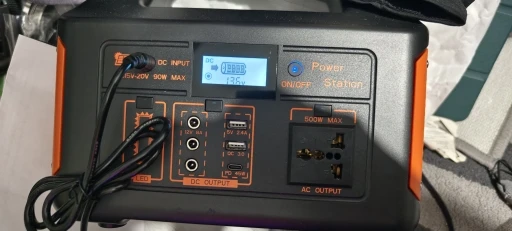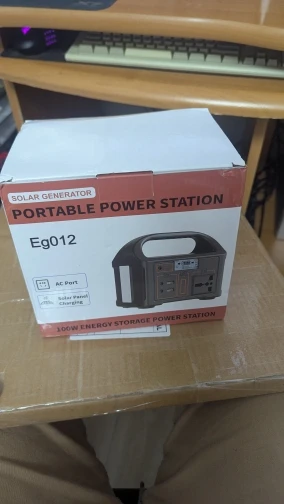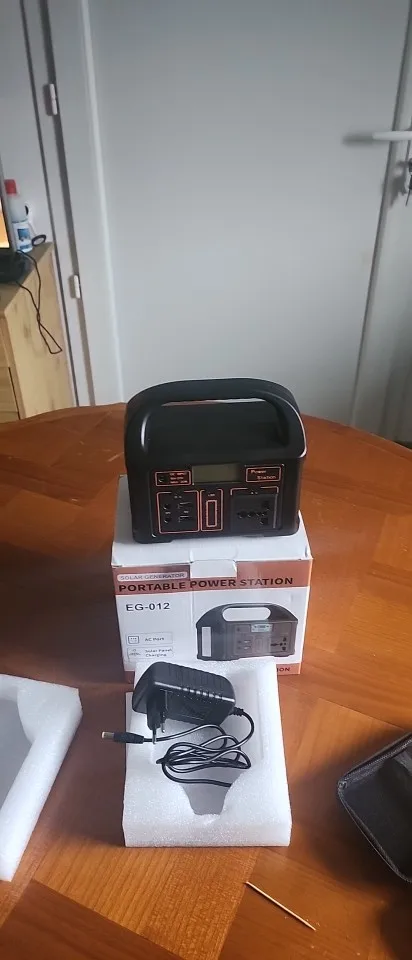Estación de Energía Portátil Solar 100W/300W/500W con Baterías LiFePO4 – Almacenamiento de Energía 110V/220V para Camping y Viajes en RV
Nos complace informarle que todos los productos están en stock y utilizan celdas de batería de grado A completamente nuevas. Las baterías se envían directamente por vía aérea y llegarán en 10-15 días. Puede comprar con confianza, sin necesidad de pagar ningún costo adicional: ¡disfrute de compras libres de impuestos!
| Elemento | 100W | 300W | 500W |
|---|---|---|---|
| Potencia Nominal | 100W | 300W | 500W |
| Forma de Onda de Salida | Onda Modificada | Onda Senoidal Pura | Onda Senoidal Pura |
| Voltaje de Salida AC | 220V/110V ±15% | 220V/110V ±15% | 220V/110V ±15% |
| Frecuencia de Salida AC | 50Hz/60Hz ±2Hz | 50Hz/60Hz ±2Hz | 50Hz/60Hz ±2Hz |
| Eficiencia de Conversión | Valor Máximo >90% | Valor Máximo >90% | Valor Máximo >90% |
| Interfaz de Carga | Puerto de Carga Externo y Puerto de Carga Solar DC5521*1 (Controlador Solar Inteligente Integrado) | Puerto de Carga Externo y Puerto de Carga Solar DC5521*1 (Controlador Solar Inteligente Integrado) | Puerto de Carga Externo y Puerto de Carga Solar DC5521*1 (Controlador Solar Inteligente Integrado) |
| Toma de Salida AC | Toma Universal | Toma Universal | Toma Universal |
| Voltaje de Salida DC | 1 USB salida QC18W; 1 salida PD máximo 20W; USB 5V 2.4A; QC3.0; PD45W; DC12V8A, 3*Puerto DC5521 | 1 USB salida QC18W; 1 salida PD máximo 20W; USB 5V 2.4A; QC3.0; PD45W; DC12V8A, 3*Puerto DC5521 | 1 USB salida QC18W; 1 salida PD máximo 20W; USB 5V 2.4A; QC3.0; PD45W; DC12V8A, 3*Puerto DC5521 |
| Estados de Luz LED | Alta intensidad, baja intensidad, alta luminosidad, luz media, parpadeante, apagado (6 estados) | Alta intensidad, baja intensidad, alta luminosidad, luz media, parpadeante, apagado (6 estados) | Alta intensidad, baja intensidad, alta luminosidad, luz media, parpadeante, apagado (6 estados) |
| Tipo de Batería | LiFePO4 | LiFePO4 | LiFePO4 |
| Capacidad de Batería | 12.8V 76.8Wh | 12.8V 230Wh | 12.8V 460Wh |
| Especificaciones del Panel Solar | 15V-20V Máximo 50W (Opcional) | 15V-20V Máximo 50W (Opcional) | 15V-20V Máximo 90W (Opcional) |
| Corriente de Carga | Valor Máximo 2A | Valor Máximo 2.5A | Valor Máximo 6A |
| Especificaciones del Cargador AC | 15V 1A | 14.6V 2A | 16V 5A |
| Tiempo de Carga con Cargador AC | Después de descarga completa, la capacidad de la batería alcanza el 80% después de 5 horas de carga | Después de descarga completa, la capacidad de la batería alcanza el 80% después de 5 horas de carga | Después de descarga completa, la capacidad de la batería alcanza el 80% después de 5 horas de carga |
| Pantalla LCD | Capacidad de batería, voltaje de batería, estado de carga, estado de descarga | Capacidad de batería, voltaje de batería, estado de carga, estado de descarga | Capacidad de batería, voltaje de batería, estado de carga, estado de descarga |
| Disipación de Calor | Enfriamiento automático | Enfriamiento automático | Enfriamiento automático |
| Función Protectora | Bajo voltaje, sobrevoltaje, sobrecarga, sobrecalentamiento, sobrecorriente, cortocircuito | Bajo voltaje, sobrevoltaje, sobrecarga, sobrecalentamiento, sobrecorriente, cortocircuito | Bajo voltaje, sobrevoltaje, sobrecarga, sobrecalentamiento, sobrecorriente, cortocircuito |
| Temperatura de Operación | -10 ~ 40°C | -10 ~ 40°C | -10 ~ 40°C |
| Humedad de Operación | 10 ~ 85% | 10 ~ 85% | 10 ~ 85% |
| Humedad de Almacenaje | 5 ~ 90% | 5 ~ 90% | 5 ~ 90% |
| Peso Neto (kg) | ≈1.76kg | ≈2.9kg | ≈5.36kg |
| Tamaño del Producto (LWH) (mm) | 25384214 | 211160196 | 271172228 |
Características del Producto
-
Gran Capacidad y Uso Versátil: Con una capacidad de 460Wh, la estación de energía solar portátil es adecuada para una amplia variedad de situaciones, desde campamentos al aire libre y viajes en coche hasta necesidades de emergencia en el hogar durante cortes de energía. Mantén tu energía disponible en cualquier lugar y momento.
-
Batería de Fosfato de Hierro de Litio de Alta Calidad: El generador de energía está equipado con una batería de Fosfato de Hierro de Litio que garantiza más de 2000 ciclos de carga. Este paquete de batería de alta calidad asegura una vida útil más larga y un uso más seguro.
-
Compacto y Potente: Mejorado respecto a otros productos en el mercado, el banco de energía para camping al aire libre tiene un volumen más pequeño y un peso más ligero, manteniendo una funcionalidad potente. Puede alimentar una variedad de dispositivos electrónicos, lo que lo convierte en una opción conveniente y confiable para su uso al aire libre.
-
Iluminación LED y Salidas Diversas: La fuente de energía al aire libre cuenta con iluminación LED con cuatro modos: alta luminosidad, luz media, parpadeante y apagado. Ofrece salida dual USB de 5V 2.4A y salida dual DC5521 de 12V 3A, adecuada para equipos electrónicos y de exterior, proporcionando gran conveniencia.
-
Seguridad y Eficiencia: El generador portátil al aire libre se destaca por su seguridad y eficiencia. Proporciona carga rápida e incluye múltiples protecciones de seguridad, asegurando fiabilidad y durabilidad para su uso al aire libre.
Lista de Paquete
-
Estación de Energía 100W/300W/500W*1
-
Cargador (enchufe UE/EE. UU./Reino Unido opcional)*1
-
Manual del Producto*1
Si necesitas algo más o quieres adaptar la traducción, estaré encantado de ayudarte.




















FAQ
A solar panel has to be connected to a charge controller to regulate current, and a battery to store the electrical power. You will need adapter kit cables to wire the solar panel(s) and charge controller, and tray cables connecting the charge controller to a deep-cycle battery.
On-grid simply means solar power equipment (array or solar panel) is connected to the electrical grid, while off-grid refers to systems that are not connected to the grid and therefore store the generated power for later use. Off-grid systems are not affected by grid blackouts.
Solar panel performance may be hindered for a number of reasons. Most commonly environmental conditions such as indirect sunlight, temperature rise, cloudy sky, and dirt and stain build up on the top glass will cause a reduced power output.
Solar panels can be connected in series or in parallel to meet your electrical circuit size and power demand. Connecting solar panels in series will have the effect of adding up their operating voltage output, while system current output will be the same as that for one panel. While, connecting solar panels in parallel will have a different effect; individual panels operating current output will add up to be the system output current, while system output voltage will be the same as the output voltage of one solar panel. To meet the optimum power output and system rating for your power system, you can use both parallel and series connections.
The best way to gauge how many solar panels you need, is to understand and define the power load needed from this system. Power is measured in Watts, and capacity is commonly measured in Watt-hours (multiplying power output in watts by the required number of hours of operation multiplied by a safety factor of 1.5-2). Therefore, it is wise to size your battery bank first based on the minimum required capacity, and accordingly decide how many panels or how much power input is needed.
Yes, more solar panels can be added to this system to increase the power output. The Rover 40A has a maximum PV input current of 40A, maximum PV input voltage of 100VDC, and maximum input solar power of 520W at 12V or 1040W at 24V. You can wire more solar panels in series / in parallel to achieve larger power output, however you are limited by the maximum input voltage and current the charge controller can handle. It is safer to build a system operating at around 90% of the rated voltage and current to ensure there is a tolerance for any system overvoltage or overcurrent.
In order to determine what size solar kit is appropriate, you must first define the total load to be expected of the solar power system. Most manufacturers will publish a specification sheet of the AC unit online and will include a nameplate sticker on the AC body. Both can be used to determine the actual power rating of the AC. BTU is a common measuring unit for energy in AC and water heater products, however we are intrested in the energy rate, or simply power. Power will be listed in units of Watts, and can be used to determine the total load resulting from running the intended AC unit. Multiply the power rating recorded in watts by the total number of hours of operation intended, to obtain the total watt-hours. Divide the total watt-hours by the peak sun hours in the location of installation, and multiply by a safety factor of 1.5-2, to obtain the total number of watts your panels should produce to power the air conditioner load. The total power load can be divided by the power output of one panel to obtain the number of panels needed.
If you intend to use this solar power kit as a power supply for home appliances (e.g. coffee maker, TV, etc.), then you will need an inverter to convert the output voltage from a 12 VDC system to a 120V AC output socket. Renogy offers a variety of inverter products to suit your unique system and meet your power demand.
More questions about your solar products? Learn more from JSDSOLAR Support!











